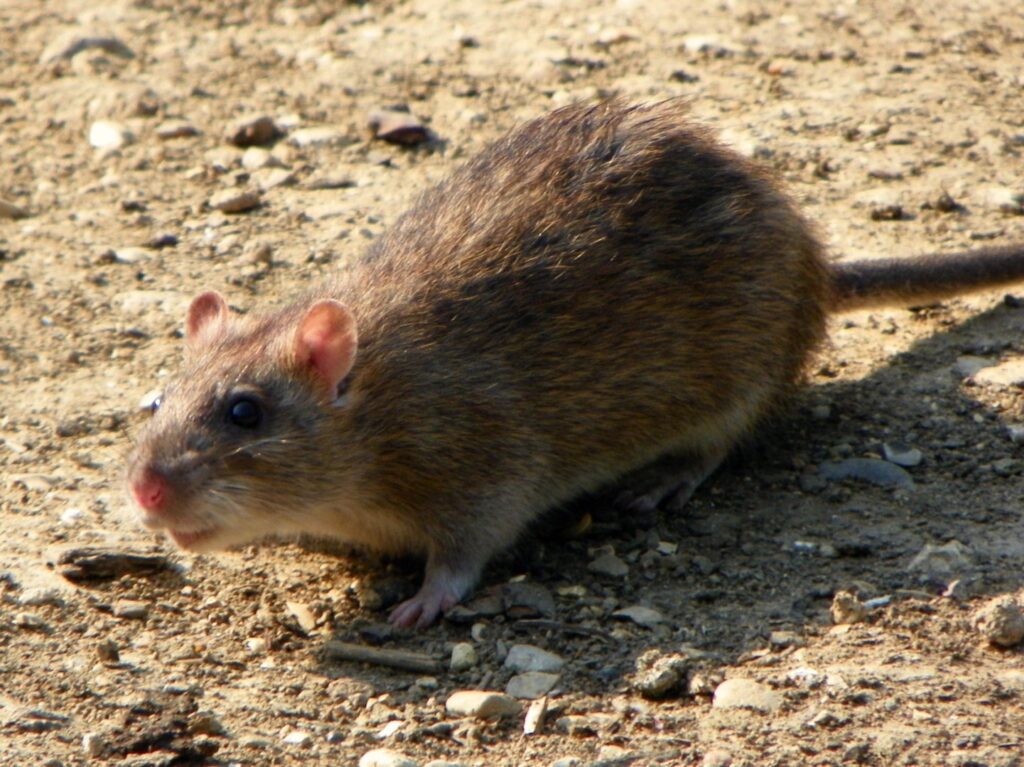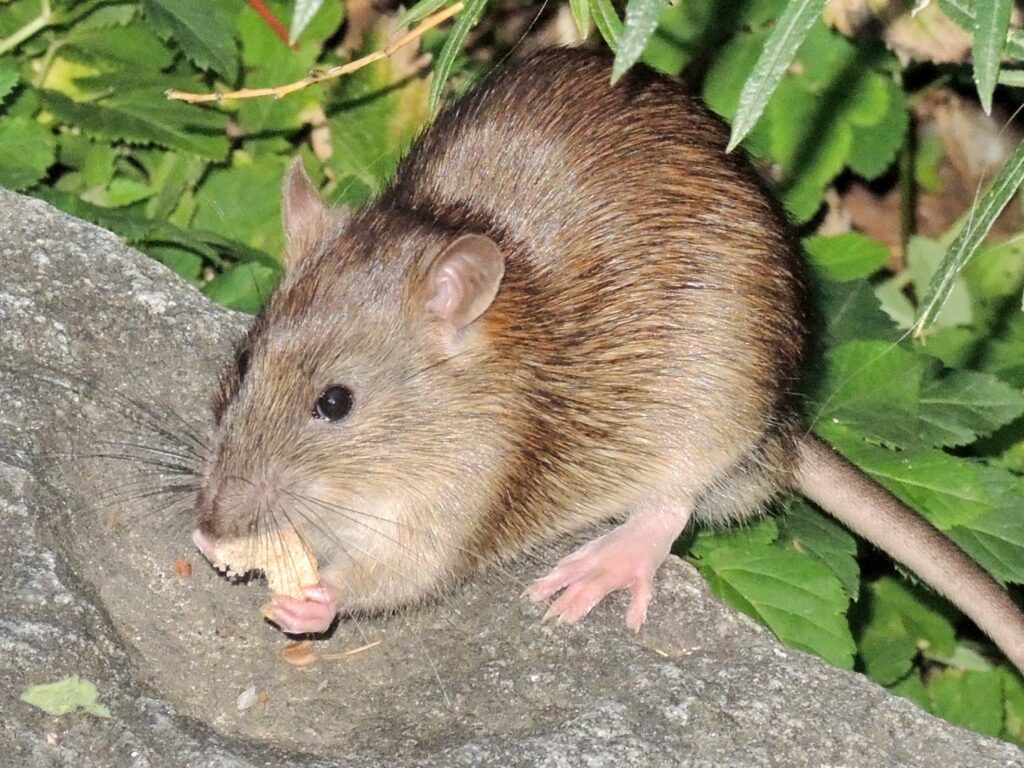Rats
What is a Rat?
Rats belong to the rodent family and are known for their ability to adapt and survive in various environments, including urban and rural areas. These omnivorous animals are attracted to human and pet food, often entering homes and infrastructures to feed and nest. The risks associated with the presence of rats include food contamination, the spread of diseases such as leptospirosis, and structural damage to buildings.
How to Identify Rats?
Rats, with their notably larger size compared to most other domestic rodents, possess a long tail that can measure up to the length of their body, large ears, and a distinctly pointed snout, useful for scavenging for food and shelter.
Tell-tale signs of a rat infestation include scratching and scurrying noises from walls or ceilings, especially at night, the discovery of dark, capsule-shaped rat poop, characteristic grease marks left on frequently traveled routes along walls, and gnawed electrical cables, which can pose fire risks.
Nests made from shredded materials such as paper or insulation are often hidden in secluded and hard-to-reach places like attics, basements, behind appliances, or even under floorboards, providing rats with a safe haven for breeding and hiding during the day.

Additional Information on Rats
Pest Type
Adaptable and resilient rodent, posing significant challenges for pest control.
Appearance
Rats display a large size for a rodent, with a distinctly long tail that can be almost as long as their body, large ears, and a pointed snout to aid in exploration and feeding.
Lifespan
Rats can live up to 3 years in the wild, though the average lifespan is often shorter in urban environments due to dangers and control efforts.
Habitat
Highly versatile, adapting to a wide range of environments from dense urban areas with complex sewer systems to open countryside, utilizing human structures for nesting and feeding.
Diet
Omnivores with a marked preference for grains, fruits, and waste, attracting them to human-inhabited areas where these food sources are abundant.
Life Cycle
Rats’ ability to produce multiple litters per year, each with several young, allows their populations to grow quickly without control, emphasizing the importance of early and effective intervention to limit reproduction.
Do I Have a Rat Problem?
If you observe signs such as scratching noises, droppings, or damage to structures and electrical wires, it is time to call a professional. Exterminapro can help you identify and eliminate rats safely and effectively.
Signs of a Rat Infestation
- Rat Poop: The presence of fresh, small, dark, capsule-shaped droppings is a clear indicator of recent rat activity. These are often concentrated along walls, near nesting areas, and food sources.
- Grease Marks: Rats often leave grease marks and rub marks along their habitual paths from the contact of their fur with surfaces.
- Material Damage: Rats can cause considerable damage by gnawing on various materials, including electrical wires, which can present a fire risk, and wooden structures, compromising the building’s integrity.


Risks Associated with Rats
Rats pose a significant threat not only to the safety of inhabited structures by causing substantial structural damage through their habit of gnawing on wood, plastic, and even some types of concrete, but also to human health. They are vectors of serious diseases such as leptospirosis, salmonellosis, and hantavirus, which can be transmitted directly by contact with rats or indirectly through their droppings or urine.
Food stock contamination by these pests can lead to severe public health problems, in addition to economic losses from having to replace contaminated food. Damage to electrical cables and other installations can result in costly and dangerous outages. Given these risks, intervention by Exterminapro, with its proven and safe extermination solutions, is essential to effectively eradicate rat populations and prevent re-infestations, protecting your health, property, and ensuring a safe environment.
Treatments to Get Rid of Rats
Eliminating rats requires an integrated strategy, including using traps, modifying the environment to reduce food and shelter sources, and in some cases, using rodenticides by professionals.
Preventing Rat Infestations
- Eliminating Food Sources: Storing food, including pet food, in tightly sealed containers prevents rats from accessing easy food sources, significantly reducing their interest in a habitat.
- Securing the Habitat: Blocking potential entry points by sealing holes and cracks with rodent-resistant materials like metal or concrete can effectively prevent rats from entering structures.
- Hygiene and Cleaning: Regular maintenance and the removal of debris and wood piles near homes discourage rats from nesting and reproducing by reducing potential hiding spots.
Types of Treatments to Control Rats
- Traps: Mechanical traps, such as snap traps and glue traps, offer an effective and non-toxic method for capturing rats. These devices should be strategically placed along commonly traveled paths to maximize captures without risking the health of residents and pets.
- Rodenticides: Using rodenticides by qualified professionals ensures effective elimination of rat populations while minimizing risks to non-targets. These substances are applied in inaccessible areas to children and pets, following strict protocols to avoid accidental contamination.
- Exclusion: Implementing exclusion techniques is essential to prevent new rats from entering. This includes repairing cracks in foundations, installing screens on ventilation openings, and ensuring doors and windows are well-sealed.
How to Permanently Eradicate Rats?
For permanent rat eradication, it is essential to combine professional extermination methods with ongoing preventive measures. Exterminapro uses advanced and safe techniques to resolve your rat infestation problems, ensuring lasting peace of mind.
Intervention Process
How Much Does It Cost?
Get a Free Estimate
The cost of rat intervention depends on the extent of the infestation and the necessary treatment methods. Exterminapro offers a free assessment to determine the best extermination strategy tailored to your situation. Contact us now for a consultation and take the first steps towards a rat-free environment.







